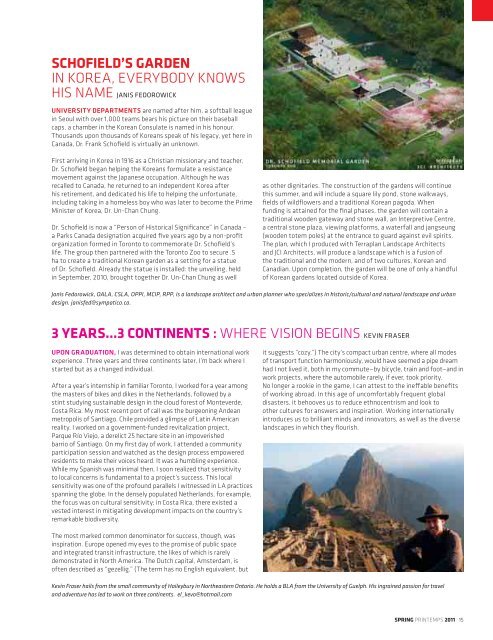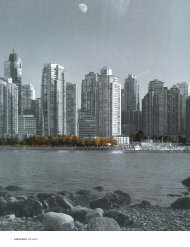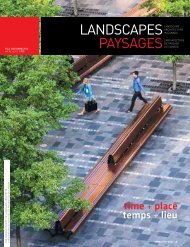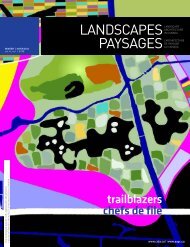Spring | Printemps 2011 - CSLA :: AAPC
Spring | Printemps 2011 - CSLA :: AAPC
Spring | Printemps 2011 - CSLA :: AAPC
You also want an ePaper? Increase the reach of your titles
YUMPU automatically turns print PDFs into web optimized ePapers that Google loves.
SCHOFIELD’S GARDEN<br />
IN KOREA, EVERYBODY KNOW S<br />
HIS NAME JANIS FEDOROWICK<br />
UNIVERSITY DEPARTMENTS are named after him, a softball league<br />
in Seoul with over 1,000 teams bears his picture on their baseball<br />
caps, a chamber in the Korean Consulate is named in his honour.<br />
Thousands upon thousands of Koreans speak of his legacy, yet here in<br />
Canada, Dr. Frank Schofield is virtually an unknown.<br />
First arriving in Korea in 1916 as a Christian missionary and teacher,<br />
Dr. Schofield began helping the Koreans formulate a resistance<br />
movement against the Japanese occupation. Although he was<br />
recalled to Canada, he returned to an independent Korea after<br />
his retirement, and dedicated his life to helping the unfortunate,<br />
including taking in a homeless boy who was later to become the Prime<br />
Minister of Korea, Dr. Un-Chan Chung.<br />
Dr. Schofield is now a “Person of Historical Significance” in Canada –<br />
a Parks Canada designation acquired five years ago by a non-profit<br />
organization formed in Toronto to commemorate Dr. Schofield’s<br />
life. The group then partnered with the Toronto Zoo to secure .5<br />
ha to create a traditional Korean garden as a setting for a statue<br />
of Dr. Schofield. Already the statue is installed: the unveiling, held<br />
in September, 2010, brought together Dr. Un-Chan Chung as well<br />
as other dignitaries. The construction of the gardens will continue<br />
this summer, and will include a square lily pond, stone walkways,<br />
fields of wildflowers and a traditional Korean pagoda. When<br />
funding is attained for the final phases, the garden will contain a<br />
traditional wooden gateway and stone wall, an Interpretive Centre,<br />
a central stone plaza, viewing platforms, a waterfall and jangseung<br />
(wooden totem poles) at the entrance to guard against evil spirits.<br />
The plan, which I produced with Terraplan Landscape Architects<br />
and JCI Architects, will produce a landscape which is a fusion of<br />
the traditional and the modern, and of two cultures, Korean and<br />
Canadian. Upon completion, the garden will be one of only a handful<br />
of Korean gardens located outside of Korea.<br />
Janis Fedorowick, OALA, <strong>CSLA</strong>, OPPI, MCIP, RPP, is a landscape architect and urban planner who specializes in historic/cultural and natural landscape and urban<br />
design. janisfed@sympatico.ca.<br />
3 YEARS...3 CONTINENTS : WHERE VISION BEGINS KEVIN FRASER<br />
UPON GRADUATION, I was determined to obtain international work<br />
experience. Three years and three continents later, I’m back where I<br />
started but as a changed individual.<br />
After a year’s internship in familiar Toronto, I worked for a year among<br />
the masters of bikes and dikes in the Netherlands, followed by a<br />
stint studying sustainable design in the cloud forest of Monteverde,<br />
Costa Rica. My most recent port of call was the burgeoning Andean<br />
metropolis of Santiago. Chile provided a glimpse of Latin American<br />
reality. I worked on a government-funded revitalization project,<br />
Parque Río Viejo, a derelict 25 hectare site in an impoverished<br />
barrio of Santiago. On my first day of work, I attended a community<br />
participation session and watched as the design process empowered<br />
residents to make their voices heard. It was a humbling experience.<br />
While my Spanish was minimal then, I soon realized that sensitivity<br />
to local concerns is fundamental to a project’s success. This local<br />
sensitivity was one of the profound parallels I witnessed in LA practices<br />
spanning the globe. In the densely populated Netherlands, for example,<br />
the focus was on cultural sensitivity; in Costa Rica, there existed a<br />
vested interest in mitigating development impacts on the country’s<br />
remarkable biodiversity.<br />
it suggests “cozy.”) The city’s compact urban centre, where all modes<br />
of transport function harmoniously, would have seemed a pipe dream<br />
had I not lived it, both in my commute—by bicycle, train and foot—and in<br />
work projects, where the automobile rarely, if ever, took priority.<br />
No longer a rookie in the game, I can attest to the ineffable benefits<br />
of working abroad. In this age of uncomfortably frequent global<br />
disasters, it behooves us to reduce ethnocentrism and look to<br />
other cultures for answers and inspiration. Working internationally<br />
introduces us to brilliant minds and innovators, as well as the diverse<br />
landscapes in which they flourish.<br />
The most marked common denominator for success, though, was<br />
inspiration. Europe opened my eyes to the promise of public space<br />
and integrated transit infrastructure, the likes of which is rarely<br />
demonstrated in North America. The Dutch capital, Amsterdam, is<br />
often described as “gezellig.” (The term has no English equivalent. but<br />
Kevin Fraser hails from the small community of Haileybury in Northeastern Ontario. He holds a BLA from the University of Guelph. His ingrained passion for travel<br />
and adventure has led to work on three continents. el_kevo@hotmail.com<br />
SPRING PRINTEMPS <strong>2011</strong> 15






